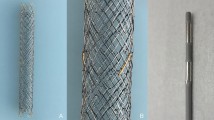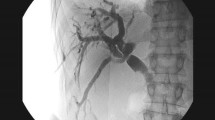Abstract
Background
Endoscopic radiofrequency ablation (RFA) is expected to prolong stent patency for malignant biliary obstruction (MBO). However, its feasibility when used in conjunction with a balloon enteroscope (BE) in patients with surgically altered anatomy (SAA) remains unknown.
Aims
This study aimed to investigate the feasibility of RFA combined with metal stent insertion under BE guidance for MBO in patients with SAA.
Methods
Thirty-seven patients who underwent treatment between October 2016 and January 2021 and met the eligibility criteria were investigated retrospectively. Study outcomes included technical and clinical success, recurrent biliary obstruction (RBO), and other adverse events besides RBO associated with RFA with metal stent placement using BE.
Results
Technical and clinical success rates were 100% (37/37) each. The rates of early and late adverse events were 8.1% (3/37) and 8.1% (3/37), respectively. RBO occurred in 32.4% (12/37) of the patients, and the median time to RBO was 296 days. The cause of RBO was ingrowth in eight patients, overgrowth in three patients, and indeterminate in one patient. All reinterventions for RBO were successful using the BE approach; all ingrowths, except one, were recanalized using additional RFA without additional stent placement. The frequency of reintervention-related adverse events was 9.1% (1/11). The median time to RBO after reintervention was 166 days.
Conclusions
This study demonstrated the technical safety and feasibility as well as good long-term outcomes of endobiliary RFA combined with metal stent placement under BE guidance. This approach may be a useful option for treating MBO in patients with SAA.




Similar content being viewed by others
References
Dumonceau JM, Tringali A, Papanikolaou IS et al. Endoscopic biliary stenting: indications, choice of stents, and results: European Society of Gastrointestinal Endoscopy (ESGE) Clinical Guideline-Updated October 2017. Endoscopy 2018;50:910–930.
Almadi MA, Barkun A, Martel M. Plastic vs. self-expandable metal stents for palliation in malignant biliary obstruction: a series of meta-analyses. Am J Gastroenterol 2017;112:260–273.
Aabakken L, Bretthauer M, Line PD. Double-balloon enteroscopy for endoscopic retrograde cholangiography in patients with a Roux-en-Y anastomosis. Endoscopy 2007;39:1068–1071.
Wang AY, Sauer BG, Behm BW et al. Single-balloon enteroscopy effectively enables diagnostic and therapeutic retrograde cholangiography in patients with surgically altered anatomy. Gastrointest Endosc 2010;71:641–649.
Shimatani M, Hatanaka H, Kogure H et al. Diagnostic and therapeutic endoscopic retrograde cholangiography using a short-type double-balloon endoscope in patients with altered gastrointestinal anatomy: a multicenter prospective study in Japan. Am J Gastroenterol 2016;111:1750–1758.
Shimatani M, Mitsuyama T, Tokuhara M et al. Recent advances of endoscopic retrograde cholangiopancreatography using balloon assisted endoscopy for pancreaticobiliary diseases in patients with surgically altered anatomy: therapeutic strategy and management of difficult cases. Dig Endosc. 2020. https://doi.org/10.1111/den.13848.
Tanisaka Y, Ryozawa S, Mizuide M et al. Status of single-balloon enteroscopy-assisted endoscopic retrograde cholangiopancreatography in patients with surgically altered anatomy: systematic review and meta-analysis on biliary interventions. Dig Endosc. 2020. https://doi.org/10.1111/den.13878.
Togawa O, Isayama H, Tsujino T et al. Management of dysfunctional covered self-expandable metallic stents in patients with malignant distal biliary obstruction. J Gastroenterol 2013;48:1300–1307.
Inoue T, Naitoh I, Suzuki Y et al. Multi-center study of endoscopic revision after side-by-side metal stent placement for malignant hilar biliary obstruction. Dig Endosc. 2020. https://doi.org/10.1111/den.13854.
Sofi AA, Khan MA, Das A et al. Radiofrequency ablation combined with biliary stent placement versus stent placement alone for malignant biliary strictures: a systematic review and meta-analysis. Gastrointest Endosc 2018;87:944-951.e1.
Larghi A, Rimbaș M, Tringali A, Boškoski I, Rizzatti G, Costamagna G. Endoscopic radiofrequency biliary ablation treatment: a comprehensive review. Dig Endosc 2019;31:245–255.
Inoue T, Yoneda M. Updated evidence on the clinical impact of endoscopic radiofrequency ablation in the treatment of malignant biliary obstruction. Dig Endosc. 2021. https://doi.org/10.1111/den.14059.
Inoue T, Ibusuki M, Kitano R et al. Endobiliary radiofrequency ablation combined with bilateral metal stent placement for malignant hilar biliary obstruction. Endoscopy. 2020;52:595–599.
Inoue T, Kitano R, Yoneda M. Endobiliary radiofrequency ablation for ingrowth occlusion after bilateral metal stent placement in patients with malignant hilar biliary obstruction. Endosc Int Open. 2021;9:E907–E908.
Isayama H, Hamada T, Yasuda I et al. TOKYO criteria 2014 for transpapillary biliary stenting. Dig Endosc. 2015;27:259–264.
Kanda Y. Investigation of the freely available easy-to-use software “EZR” for medical statistics. Bone Marrow Transpl 2013;48:452–458.
Inoue T, Ito K, Yoneda M. Radiofrequency ablation combined with multiple biliary metal stent placement using short-type single-balloon endoscope in patients with surgically altered anatomy. Dig Endosc. 2018;30:395–396.
Tanisaka Y, Ryozawa S, Mizuide M et al. Usefulness of self-expandable metal stents for malignant biliary obstruction using a short-type single-balloon enteroscope in patients with surgically altered anatomy. J Hepatobiliary Pancreat Sci. 2021. https://doi.org/10.1002/jhbp.889.
Atar M, Kadayifci A, Daglilar E, Hagen C, Fernandez-Del Castillo C, Brugge WR. Ex vivo human bile duct radiofrequency ablation with a bipolar catheter. Surg Endosc. 2018;32:2808–2813.
Kim EJ, Chung DH, Kim YJ et al. Endobiliary radiofrequency ablation for distal extrahepatic cholangiocarcinoma: a clinicopathological study. PLoS ONE 2018;13:e0206694.
Yamauchi H, Kida M, Okuwaki K et al. A case series: outcomes of endoscopic biliary self-expandable metal stent for malignant biliary obstruction with surgically altered anatomy. Dig Dis Sci 2016;61:2436–2441. https://doi.org/10.1007/s10620-016-4148-8.
Pai M, Valek V, Tomas A et al. Percutaneous intraductal radiofrequency ablation for clearance of occluded metal stent in malignant biliary obstruction: feasibility and early results. Cardiovasc Intervent Radiol. 2014;37:235–240.
Kallis Y, Phillips N, Steel A et al. Analysis of endoscopic radiofrequency ablation of biliary malignant strictures in pancreatic cancer suggests potential survival benefit. Dig Dis Sci 2015;60:3449–3455. https://doi.org/10.1007/s10620-015-3731-8.
Yang J, Wang J, Zhou H et al. Efficacy and safety of endoscopic radiofrequency ablation for unresectable extrahepatic cholangiocarcinoma: a randomized trial. Endoscopy. 2018;50:751–760.
Gao DJ, Yang JF, Ma SR et al. Endoscopic radiofrequency ablation plus plastic stent placement versus stent placement alone for unresectable extrahepatic biliary cancer: a multicenter randomized controlled trial. Gastrointest Endosc. 2021;94:91–100.
Xia MX, Pan YL, Cai XB et al. Comparison of endoscopic bilateral metal stent drainage with plastic stents in the palliation of unresectable hilar biliary malignant strictures: large multicenter study. Dig Endosc. 2020. https://doi.org/10.1111/den.13680.
Haen SP, Pereira PL, Salih HR, Rammensee HG, Gouttefangeas C. More than just tumor destruction: immunomodulation by thermal ablation of cancer. Clin Dev Immunol. 2011;2011:160250.
Giardino A, Innamorati G, Ugel S et al. Immunomodulation after radiofrequency ablation of locally advanced pancreatic cancer by monitoring the immune response in 10 patients. Pancreatology. 2017;17:962–966.
Acknowledgments
None.
Funding
No funding was received for this study.
Author information
Authors and Affiliations
Contributions
T.I.: conception and design, data acquisition, analysis and interpretation, and drafting and revision of the manuscript. M.I., R.K., K.S., S.K., Y.K., T.O., Y.S., Y.N., K.I., M.Y.: data interpretation, and revision of the manuscript.
Corresponding author
Ethics declarations
Conflict of interest
Tadahisa Inoue received honoraria from Boston Scientific Japan and Japan Lifeline Co., Ltd, outside the submitted work. All other authors have no financial relationships relevant to this publication to disclose.
Ethical approval
Aichi Medical University Hospital’s institutional review board approved this study (Approval number: 2018-H192). The study was conducted in accordance with the principles of the Declaration of Helsinki.
Additional information
Publisher's Note
Springer Nature remains neutral with regard to jurisdictional claims in published maps and institutional affiliations.
Rights and permissions
About this article
Cite this article
Inoue, T., Ibusuki, M., Kitano, R. et al. Endobiliary Radiofrequency Ablation Using a Short-Type Balloon Enteroscope in Patients with Surgically Altered Anatomy. Dig Dis Sci 67, 4181–4187 (2022). https://doi.org/10.1007/s10620-021-07224-7
Received:
Accepted:
Published:
Issue Date:
DOI: https://doi.org/10.1007/s10620-021-07224-7




